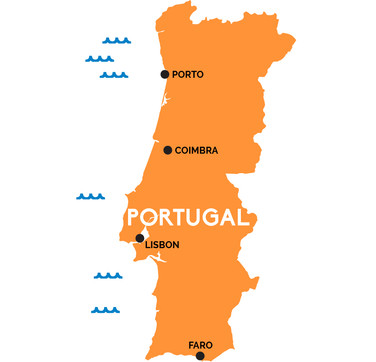Loulé is the most populous municipality ('concelho') in the Algarve and is located about 15km to the northwest of Faro (where the 'A' in FARO is in the map below). Quarteira and Vila Sol are situated in this municipality.
Loulé is a ten-minute drive from Vila Sol. We frequent it often and have come to love its charm. While it is home to many expats, it retains a distinctly Portuguese culture and personality. Jennifer has enjoyed discovering the thriving artist community that is supported and promoted by the local government, and participating in various workshops they offer.
A central feature of the town is its market. The neo-Arabic style building opened in 1908 but was renovated recently. On any day of the week, merchants offer an array of locally-sourced foods, including fresh produce, meats, fish, cheeses, nuts, jams, honey, spices, etc. On Saturdays, a farmers market spills out onto the adjacent streets, and just down the road a gypsy market offers souvenirs, clothes, handbags and wallets, shoes, and lots of cork goods.
For more mundane items, the expansive Mar shopping center and outlet stores are close to town offering virtually everything we need, with anchor stores: IKEA, Leroy Merlin (like Home Depot), and Worten (like Best Buy).
A short walk from the market is the church of São Clemente, the oldest church in Loulé, dating back to the 13th century. The bell tower, formerly a Moorish minaret, still stands and the bell still marks the time of day.
[Scroll left/right to view gallery]
Like so many Portuguese towns, Loulé's medieval old town is full of narrow, twisty, cobblestoned streets lined by small stores, coffee shops, workshops and studios. It is lovely to pop inside and see local artisans at work -- cobblers, woodworkers, potters, tile painters, weavers, coppersmiths, etc.
Of course, Loulé has a castle and it dates back to the 2nd century, but was rebuilt by the Moors, and then again in the 13th century under the rule of King Afonso III after the reconquest. Inside is a small but well-curated Municipal Archaeological Museum that contains Roman and Moorish artifacts.
Just down from the market on the Praça da República is the Café Calcinha, the most famous coffee shop in Loulé. It was opened in 1929 by José Domingos Cavaco, whose nickname was “Calcinha.” It features an art-deco interior of Brazilian wood and is a popular hangout for locals and tourists alike. Outside is a sculpture of the humble, uneducated but prolific poet, António Aleixo, who frequented the café and would recite his poems to the cafe's patrons and passers-by.
Closeby is the Convent of Espírito Santo which has been repurposed as the Loulé Design Lab, a central gathering place for local artists. It was here that Jennifer engaged with some of the artists who help fund their work by conducting workshops. Behind the Design Lab is the tallest landmark in Loulé, a pine tree that can be seen from miles around.
During the summer months, a number of festivals are held across the Algarve to celebrate all sorts of things. Probably the biggest is the Med Festival in Loulé, celebrating world music, food and culture. The old town is fenced off to contain music stages, big and small, and any number of arts, crafts, and food concessions. Decorations abound, including on the pine tree mentioned above. The three-day music program features artists from every continent (except Antarctica!). Locals dress up in traditional costumes and entertain the crowds with dance.
[Scroll left/right to view gallery]
































































Comments